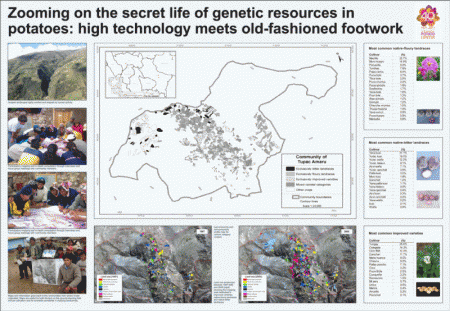- Breeding crop plants with deep roots: their role in sustainable carbon, nutrient and water sequestration. Good for soil structure, good for C sequestration, good for yields. What’s not to like?
- Ethnopharmacology, food production, nutrition and biodiversity conservation: Towards a sustainable future for indigenous peoples. Ethnopharmacologists need to think more generally about nutrition, and a lot more about conservation. And a view on the whole “wonder herb” thing from two botanical garden boffins who protest way too much as far as I’m concerned.
- Modelling predicts that heat stress, not drought, will increase vulnerability of wheat in Europe. It’s the heat, not the humidity. But maybe wild relatives can help.
- The Virtuous Manioc and the Horny Barbasco: Sublime and Grotesque Modes of Transformation in the Origin of Yanesha Plant Life. Maize is the result of a virgin birth, chili peppers of a fart. I’ll buy that.
- Is there a forest transition outside forests? Trajectories of farm trees and effects on ecosystem services in an agricultural landscape in Eastern Germany. Yes, but.
- Biodiversity and socioeconomic factors supporting farmers’ choice of wild edible trees in the agroforestry systems of Benin (West Africa). Those factors are: how important the trees are for food and medicine and how accessible they are. Still no cure for cancer. Anyway, here’s what ICRAF thinks should come next: domestication, natch.
- Pome fruit viruses at the Canadian Clonal Genebank and molecular characterization of Apple chlorotic leaf spot virus isolates. There’s a lot of them. Well that can’t be good, can it?
- A long-term view of rare plant reintroduction. A previous review is way too pessimistic.
Nibbles: Dutch soybeans, American flora and vegetation, Cassava pests, Bangladesh biocrats
- Do you have a small parcel of land in the Netherlands that you would not mind being used to test soybean varieties? Non-GMO, mind.
- Kew has a couple of new online resources on Neotropical plants.
- We need an international early warning system for cassava problems.
- “Is there anyone in Bangladesh to look deep into the workings of the biocrats who are bent on advancing the cause of giant companies at the expense of the people’s long-term food security?”
Nibbles: Drought, Babylonian gardens, Armenian flora, Urban veggies
- NASA says there has not been a drought-driven decline in plant productivity after all. Yeah but where’s my jet-pack, guys?
- Hanging Gardens of Babylon had date palms and tamarisk. At least.
- Edible wild Armenian plants.
- AVRDC on how to grow vegetables in all sorts of different containers.
Mapping potato genetic resources
And speaking of genetic erosion:
Land use tendencies between 1997 and 2005 shows that the total cropping area dedicated to improved cultivars has grown fast while the area reserved for native-floury and native-bitter landrace has remained more or less stable. Reduced fallow periods for existing fields and the gradual incorporating of high-altitude virgin pasture lands sustain areal growth. While areas of improved cultivars are proportionally growing fastest at extremely high altitudes between 3,900 and 4,350 m of altitude, overall cropping intensity or fallowing rates are inversely related to altitude. No evidence of a straightforward replacement of one cultivar category by another was found.
That’s from the winners of the third prize at the SCGIS/ESRI/SCB International Conservation Mapping Contest, Traditional Cartography section: CIP’s Henry Saul Juarez Soto, with Franklin Plasencia and Stef de Haan. Worth reading the whole thing.
Nibbles: European diversity, Cassava bugs, Livestock funding, Malnutrition
- Genetic diversity in European men and one of the organisms they exploit. And another.
- CIAT cassava entomologist rings warning bell.
- ILRI boffins point out why they don’t have enough money. Yeah, but what’s to be done about it?
- Malnutrition in Kenya and Guatemala. Are school gardens an/the answer? FAO thinks so.
